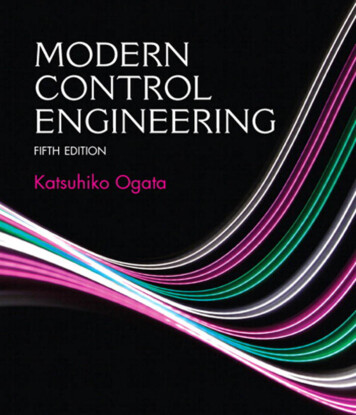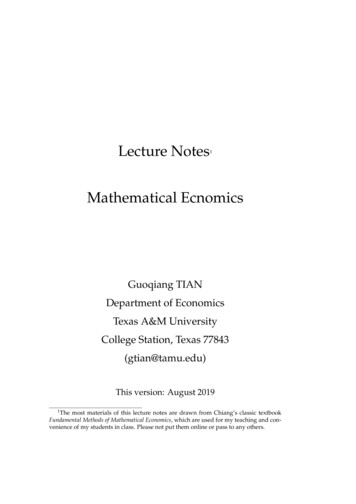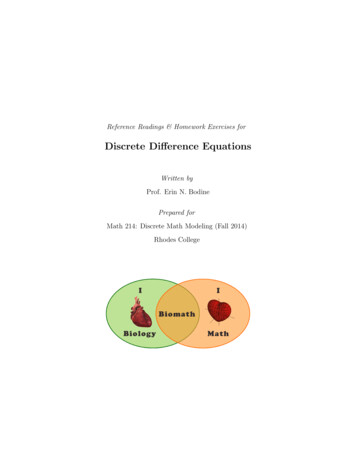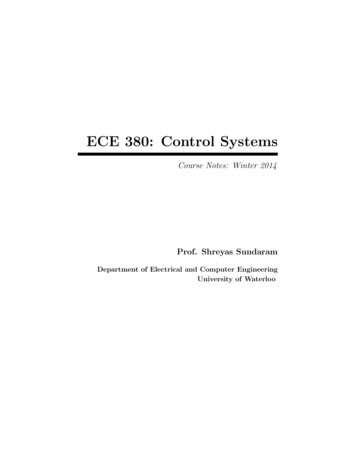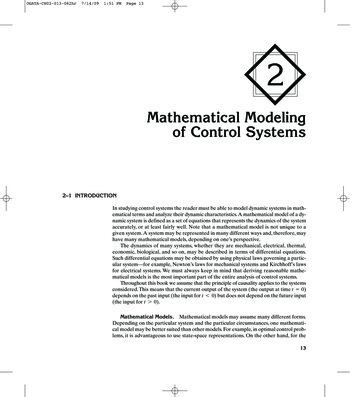
Transcription
OGATA-CH02-013-062hr7/14/091:51 PMPage 132Mathematical Modelingof Control Systems2–1 INTRODUCTIONIn studying control systems the reader must be able to model dynamic systems in mathematical terms and analyze their dynamic characteristics.A mathematical model of a dynamic system is defined as a set of equations that represents the dynamics of the systemaccurately, or at least fairly well. Note that a mathematical model is not unique to agiven system. A system may be represented in many different ways and, therefore, mayhave many mathematical models, depending on one’s perspective.The dynamics of many systems, whether they are mechanical, electrical, thermal,economic, biological, and so on, may be described in terms of differential equations.Such differential equations may be obtained by using physical laws governing a particular system—for example, Newton’s laws for mechanical systems and Kirchhoff’s lawsfor electrical systems. We must always keep in mind that deriving reasonable mathematical models is the most important part of the entire analysis of control systems.Throughout this book we assume that the principle of causality applies to the systemsconsidered. This means that the current output of the system (the output at time t 0)depends on the past input (the input for t 0) but does not depend on the future input(the input for t 0).Mathematical Models. Mathematical models may assume many different forms.Depending on the particular system and the particular circumstances, one mathematical model may be better suited than other models. For example, in optimal control problems, it is advantageous to use state-space representations. On the other hand, for the13
OGATA-CH02-013-062hr7/14/091:51 PMPage 14transient-response or frequency-response analysis of single-input, single-output, linear,time-invariant systems, the transfer-function representation may be more convenientthan any other. Once a mathematical model of a system is obtained, various analyticaland computer tools can be used for analysis and synthesis purposes.Simplicity Versus Accuracy. In obtaining a mathematical model, we must makea compromise between the simplicity of the model and the accuracy of the results ofthe analysis. In deriving a reasonably simplified mathematical model, we frequently findit necessary to ignore certain inherent physical properties of the system. In particular,if a linear lumped-parameter mathematical model (that is, one employing ordinary differential equations) is desired, it is always necessary to ignore certain nonlinearities anddistributed parameters that may be present in the physical system. If the effects thatthese ignored properties have on the response are small, good agreement will be obtainedbetween the results of the analysis of a mathematical model and the results of theexperimental study of the physical system.In general, in solving a new problem, it is desirable to build a simplified model so thatwe can get a general feeling for the solution.A more complete mathematical model maythen be built and used for a more accurate analysis.We must be well aware that a linear lumped-parameter model, which may be valid inlow-frequency operations, may not be valid at sufficiently high frequencies, since the neglected property of distributed parameters may become an important factor in the dynamicbehavior of the system. For example, the mass of a spring may be neglected in lowfrequency operations, but it becomes an important property of the system at high frequencies. (For the case where a mathematical model involves considerable errors, robustcontrol theory may be applied. Robust control theory is presented in Chapter 10.)Linear Systems. A system is called linear if the principle of superpositionapplies. The principle of superposition states that the response produced by thesimultaneous application of two different forcing functions is the sum of the twoindividual responses. Hence, for the linear system, the response to several inputs canbe calculated by treating one input at a time and adding the results. It is this principlethat allows one to build up complicated solutions to the linear differential equationfrom simple solutions.In an experimental investigation of a dynamic system, if cause and effect are proportional, thus implying that the principle of superposition holds, then the system canbe considered linear.Linear Time-Invariant Systems and Linear Time-Varying Systems. A differential equation is linear if the coefficients are constants or functions only of the independent variable. Dynamic systems that are composed of linear time-invariantlumped-parameter components may be described by linear time-invariant differential equations—that is, constant-coefficient differential equations. Such systems arecalled linear time-invariant (or linear constant-coefficient) systems. Systems thatare represented by differential equations whose coefficients are functions of timeare called linear time-varying systems. An example of a time-varying control system is a spacecraft control system. (The mass of a spacecraft changes due to fuelconsumption.)14Chapter 2 / Mathematical Modeling of Control Systems
OGATA-CH02-013-062hr7/14/091:51 PMPage 15Outline of the Chapter. Section 2–1 has presented an introduction to the mathematical modeling of dynamic systems. Section 2–2 presents the transfer function andimpulse-response function. Section 2–3 introduces automatic control systems and Section 2–4 discusses concepts of modeling in state space. Section 2–5 presents state-spacerepresentation of dynamic systems. Section 2–6 discusses transformation of mathematical models with MATLAB. Finally, Section 2–7 discusses linearization of nonlinearmathematical models.2–2 TRANSFER FUNCTION AND IMPULSERESPONSE FUNCTIONIn control theory, functions called transfer functions are commonly used to characterize the input-output relationships of components or systems that can be described by linear, time-invariant, differential equations. We begin by defining the transfer functionand follow with a derivation of the transfer function of a differential equation system.Then we discuss the impulse-response function.Transfer Function. The transfer function of a linear, time-invariant, differentialequation system is defined as the ratio of the Laplace transform of the output (responsefunction) to the Laplace transform of the input (driving function) under the assumptionthat all initial conditions are zero.Consider the linear time-invariant system defined by the following differential equation:(n)(n - 1)#a0 y a1y p an - 1 y an y(m)(m - 1)# b0 x b1x p bm - 1 x bm x(n m)where y is the output of the system and x is the input. The transfer function of this system is the ratio of the Laplace transformed output to the Laplace transformed inputwhen all initial conditions are zero, orTransfer function G(s) l[output]2l[input] zero initial conditionsY(s)b0 sm b1 sm - 1 p bm - 1 s bm X(s)a0 sn a1 sn - 1 p an - 1 s anBy using the concept of transfer function, it is possible to represent system dynamics by algebraic equations in s. If the highest power of s in the denominator of the transfer function is equal to n, the system is called an nth-order system.Comments on Transfer Function. The applicability of the concept of the transfer function is limited to linear, time-invariant, differential equation systems. The transfer function approach, however, is extensively used in the analysis and design of suchsystems. In what follows, we shall list important comments concerning the transfer function. (Note that a system referred to in the list is one described by a linear, time-invariant,differential equation.)Section 2–2 / Transfer Function and Impulse-Response Function15
OGATA-CH02-013-062hr7/14/091:51 PMPage 161. The transfer function of a system is a mathematical model in that it is an operational method of expressing the differential equation that relates the output variable to the input variable.2. The transfer function is a property of a system itself, independent of the magnitudeand nature of the input or driving function.3. The transfer function includes the units necessary to relate the input to the output;however, it does not provide any information concerning the physical structure ofthe system. (The transfer functions of many physically different systems can beidentical.)4. If the transfer function of a system is known, the output or response can be studied for various forms of inputs with a view toward understanding the nature ofthe system.5. If the transfer function of a system is unknown, it may be established experimentally by introducing known inputs and studying the output of the system. Onceestablished, a transfer function gives a full description of the dynamic characteristics of the system, as distinct from its physical description.Convolution Integral.G(s) isFor a linear, time-invariant system the transfer functionG(s) Y(s)X(s)where X(s) is the Laplace transform of the input to the system and Y(s) is the Laplacetransform of the output of the system, where we assume that all initial conditions involved are zero. It follows that the output Y(s) can be written as the product of G(s) andX(s), orY(s) G(s)X(s)(2–1)Note that multiplication in the complex domain is equivalent to convolution in the timedomain (see Appendix A), so the inverse Laplace transform of Equation (2–1) is givenby the following convolution integral:ty(t) 30x(t)g(t - t) dtt 30g(t)x(t - t) dtwhere both g(t) and x(t) are 0 for t 0.Impulse-Response Function. Consider the output (response) of a linear timeinvariant system to a unit-impulse input when the initial conditions are zero. Since theLaplace transform of the unit-impulse function is unity, the Laplace transform of theoutput of the system isY(s) G(s)16Chapter 2 / Mathematical Modeling of Control Systems(2–2)
OGATA-CH02-013-062hr7/14/091:51 PMPage 17The inverse Laplace transform of the output given by Equation (2–2) gives the impulseresponse of the system. The inverse Laplace transform of G(s), orl-1 CG(s)D g(t)is called the impulse-response function. This function g(t) is also called the weightingfunction of the system.The impulse-response function g(t) is thus the response of a linear time-invariantsystem to a unit-impulse input when the initial conditions are zero. The Laplace transform of this function gives the transfer function. Therefore, the transfer function andimpulse-response function of a linear, time-invariant system contain the same information about the system dynamics. It is hence possible to obtain complete information about the dynamic characteristics of the system by exciting it with an impulseinput and measuring the response. (In practice, a pulse input with a very short duration compared with the significant time constants of the system can be considered animpulse.)2–3 AUTOMATIC CONTROL SYSTEMSA control system may consist of a number of components. To show the functionsperformed by each component, in control engineering, we commonly use a diagramcalled the block diagram. This section first explains what a block diagram is. Next, itdiscusses introductory aspects of automatic control systems, including various controlactions.Then, it presents a method for obtaining block diagrams for physical systems, and,finally, discusses techniques to simplify such diagrams.Block Diagrams. A block diagram of a system is a pictorial representation of thefunctions performed by each component and of the flow of signals. Such a diagram depicts the interrelationships that exist among the various components. Differing from apurely abstract mathematical representation, a block diagram has the advantage ofindicating more realistically the signal flows of the actual system.In a block diagram all system variables are linked to each other through functionalblocks. The functional block or simply block is a symbol for the mathematical operationon the input signal to the block that produces the output. The transfer functions of thecomponents are usually entered in the corresponding blocks, which are connected by arrows to indicate the direction of the flow of signals. Note that the signal can pass onlyin the direction of the arrows. Thus a block diagram of a control system explicitly showsa unilateral property.Figure 2–1 shows an element of the block diagram. The arrowhead pointing towardthe block indicates the input, and the arrowhead leading away from the block represents the output. Such arrows are referred to as signals.TransferfunctionG(s)Figure 2–1Element of a blockdiagram.Section 2–3 / Automatic Control Systems17
OGATA-CH02-013-062hr7/14/091:51 PMPage 18Note that the dimension of the output signal from the block is the dimension of theinput signal multiplied by the dimension of the transfer function in the block.The advantages of the block diagram representation of a system are that it is easyto form the overall block diagram for the entire system by merely connecting the blocksof the components according to the signal flow and that it is possible to evaluate thecontribution of each component to the overall performance of the system.In general, the functional operation of the system can be visualized more readily byexamining the block diagram than by examining the physical system itself. A block diagram contains information concerning dynamic behavior, but it does not include anyinformation on the physical construction of the system. Consequently, many dissimilarand unrelated systems can be represented by the same block diagram.It should be noted that in a block diagram the main source of energy is not explicitlyshown and that the block diagram of a given system is not unique. A number of differentblock diagrams can be drawn for a system, depending on the point of view of the analysis.a a–b–bFigure 2–2Summing point.Summing Point. Referring to Figure 2–2, a circle with a cross is the symbol thatindicates a summing operation. The plus or minus sign at each arrowhead indicateswhether that signal is to be added or subtracted. It is important that the quantities beingadded or subtracted have the same dimensions and the same units.Branch Point. A branch point is a point from which the signal from a block goesconcurrently to other blocks or summing points.Block Diagram of a Closed-Loop System. Figure 2–3 shows an example of ablock diagram of a closed-loop system. The output C(s) is fed back to the summingpoint, where it is compared with the reference input R(s). The closed-loop nature ofthe system is clearly indicated by the figure. The output of the block, C(s) in this case,is obtained by multiplying the transfer function G(s) by the input to the block, E(s).Anylinear control system may be represented by a block diagram consisting of blocks, summing points, and branch points.When the output is fed back to the summing point for comparison with the input, itis necessary to convert the form of the output signal to that of the input signal. Forexample, in a temperature control system, the output signal is usually the controlledtemperature. The output signal, which has the dimension of temperature, must be converted to a force or position or voltage before it can be compared with the input signal.This conversion is accomplished by the feedback element whose transfer function is H(s),as shown in Figure 2–4. The role of the feedback element is to modify the output beforeit is compared with the input. (In most cases the feedback element is a sensor that measuresSummingpointR(s)BranchpointE(s) –C(s)G(s)Figure 2–3Block diagram of aclosed-loop system.18Chapter 2 / Mathematical Modeling of Control Systems
OGATA-CH02-013-062hr7/14/091:51 PMPage 19R(s)E(s) C(s)G(s)–B(s)Figure 2–4Closed-loop system.H(s)the output of the plant. The output of the sensor is compared with the system input, andthe actuating error signal is generated.) In the present example, the feedback signal thatis fed back to the summing point for comparison with the input is B(s) H(s)C(s).Open-Loop Transfer Function and Feedforward Transfer Function. Referring to Figure 2–4, the ratio of the feedback signal B(s) to the actuating error signalE(s) is called the open-loop transfer function. That is,Open-loop transfer function B(s) G(s)H(s)E(s)The ratio of the output C(s) to the actuating error signal E(s) is called the feedforward transfer function, so thatFeedforward transfer function C(s) G(s)E(s)If the feedback transfer function H(s) is unity, then the open-loop transfer function andthe feedforward transfer function are the same.Closed-Loop Transfer Function. For the system shown in Figure 2–4, the outputC(s) and input R(s) are related as follows: sinceC(s) G(s)E(s)E(s) R(s) - B(s) R(s) - H(s)C(s)eliminating E(s) from these equations givesC(s) G(s)CR(s) - H(s)C(s)DorG(s)C(s) R(s)1 G(s)H(s)(2–3)The transfer function relating C(s) to R(s) is called the closed-loop transfer function. Itrelates the closed-loop system dynamics to the dynamics of the feedforward elementsand feedback elements.From Equation (2–3), C(s) is given byC(s) G(s)R(s)1 G(s)H(s)Section 2–3 / Automatic Control Systems19
OGATA-CH02-013-062hr7/14/091:51 PMPage 20Thus the output of the closed-loop system clearly depends on both the closed-loop transfer function and the nature of the input.Obtaining Cascaded, Parallel, and Feedback (Closed-Loop) Transfer Functionswith MATLAB. In control-systems analysis, we frequently need to calculate the cascaded transfer functions, parallel-connected transfer functions, and feedback-connected(closed-loop) transfer functions. MATLAB has convenient commands to obtain the cascaded, parallel, and feedback (closed-loop) transfer functions.Suppose that there are two components G1(s) and G2(s) connected differently asshown in Figure 2–5 (a), (b), and (c), whereG1(s) num1,den1G2(s) num2den2To obtain the transfer functions of the cascaded system, parallel system, or feedback(closed-loop) system, the following commands may be used:[num, den] series(num1,den1,num2,den2)[num, den] parallel(num1,den1,num2,den2)[num, den] feedback(num1,den1,num2,den2)As an example, consider the case whereG1(s) 10num1, den1s 2s 102G2(s) 5num2 s 5den2MATLAB Program 2–1 gives C(s)/R(s) num den for each arrangement of G1(s)and G2(s). Note that the commandprintsys(num,den)displays the num den Cthat is, the transfer function C(s)/R(s)D of the system considered.R(s)C(s)(a)G1(s)G2(s)G1(s)R(s) (b)C(s)G2(s)R(s)Figure 2–5(a) Cascaded system;(b) parallel system;(c) feedback (closedloop) system.20C(s) –G1(s)(c)G2(s)Chapter 2 / Mathematical Modeling of Control Systems
OGATA-CH02-013-062hr7/14/091:51 PMPage 21MATLAB Program 2–1num1 [10];den1 [1 2 10];num2 [5];den2 [1 5];[num, den] en 50s 3 7s 2 20s 50[num, den] /den 5s 2 20s 100s 3 7s 2 20s 50[num, den] /den 10s 50s 3 7s 2 20s 100Automatic Controllers. An automatic controller compares the actual value ofthe plant output with the reference input (desired value), determines the deviation, andproduces a control signal that will reduce the deviation to zero or to a small value.The manner in which the automatic controller produces the control signal is calledthe control action. Figure 2–6 is a block diagram of an industrial control system, whichAutomatic controllerError detectorFigure 2–6Block diagram of anindustrial controlsystem, whichconsists of anautomatic controller,an actuator, a plant,and a sensor(measuring element).ReferenceinputSet point Output –AmplifierActuatorPlantActuatingerror signalSensorSection 2–3 / Automatic Control Systems21
OGATA-CH02-013-062hr7/14/091:51 PMPage 22consists of an automatic controller, an actuator, a plant, and a sensor (measuring element). The controller detects the actuating error signal, which is usually at a very lowpower level, and amplifies it to a sufficiently high level. The output of an automaticcontroller is fed to an actuator, such as an electric motor, a hydraulic motor, or apneumatic motor or valve. (The actuator is a power device that produces the input tothe plant according to the control signal so that the output signal will approach thereference input signal.)The sensor or measuring element is a device that converts the output variable into another suitable variable, such as a displacement, pressure, voltage, etc., that can be used tocompare the output to the reference input signal.This element is in the feedback path ofthe closed-loop system. The set point of the controller must be converted to a referenceinput with the same units as the feedback signal from the sensor or measuring element.Classifications of Industrial Controllers.classified according to their control actions as:1.2.3.4.5.6.Most industrial controllers may beTwo-position or on–off controllersProportional controllersIntegral controllersProportional-plus-integral controllersProportional-plus-derivative ive controllersMost industrial controllers use electricity or pressurized fluid such as oil or air aspower sources. Consequently, controllers may also be classified according to the kind ofpower employed in the operation, such as pneumatic controllers, hydraulic controllers,or electronic controllers. What kind of controller to use must be decided based on thenature of the plant and the operating conditions, including such considerations as safety,cost, availability, reliability, accuracy, weight, and size.Two-Position or On–Off Control Action. In a two-position control system, theactuating element has only two fixed positions, which are, in many cases, simply on andoff. Two-position or on–off control is relatively simple and inexpensive and, for this reason, is very widely used in both industrial and domestic control systems.Let the output signal from the controller be u(t) and the actuating error signal be e(t).In two-position control, the signal u(t) remains at either a maximum or minimum value,depending on whether the actuating error signal is positive or negative, so thatu(t) U1 ,for e(t) 7 0 U2 ,for e(t) 6 0where U1 and U2 are constants. The minimum value U2 is usually either zero or –U1 .Two-position controllers are generally electrical devices, and an electric solenoid-operated valve is widely used in such controllers. Pneumatic proportional controllers with veryhigh gains act as two-position controllers and are sometimes called pneumatic twoposition controllers.Figures 2–7(a) and (b) show the block diagrams for two-position or on–off controllers.The range through which the actuating error signal must move before the switching occurs22Chapter 2 / Mathematical Modeling of Control Systems
OGATA-CH02-013-062hr7/14/091:51 PMPage 23Differential gapFigure 2–7(a) Block diagram ofan on–off controller;(b) block diagram ofan on–off controllerwith differential gap. U1eu –U2U1eu–U2(a)(b)is called the differential gap. A differential gap is indicated in Figure 2–7(b). Such a differential gap causes the controller output u(t) to maintain its present value until the actuating error signal has moved slightly beyond the zero value. In some cases, the differentialgap is a result of unintentional friction and lost motion; however, quite often it is intentionally provided in order to prevent too-frequent operation of the on–off mechanism.Consider the liquid-level control system shown in Figure 2–8(a), where the electromagnetic valve shown in Figure 2–8(b) is used for controlling the inflow rate.This valve is eitheropen or closed.With this two-position control, the water inflow rate is either a positive constant or zero. As shown in Figure 2–9, the output signal continuously moves between thetwo limits required to cause the actuating element to move from one fixed position to theother. Notice that the output curve follows one of two exponential curves, one corresponding to the filling curve and the other to the emptying curve. Such output oscillation between two limits is a typical response characteristic of a system under two-position control.Movable iron core115 VqiFigure 2–8(a) Liquid-levelcontrol system;(b) electromagneticvalve.Magnetic coilFloatChR(a)(b)h(t)DifferentialgapFigure 2–9Level h(t)-versus-tcurve for the systemshown in Figure 2–8(a).0Section 2–3 / Automatic Control Systemst23
OGATA-CH02-013-062hr7/14/091:51 PMPage 24From Figure 2–9, we notice that the amplitude of the output oscillation canbe reduced by decreasing the differential gap. The decrease in the differentialgap, however, increases the number of on–off switchings per minute and reducesthe useful life of the component. The magnitude of the differential gap must bedetermined from such considerations as the accuracy required and the life ofthe component.Proportional Control Action. For a controller with proportional control action,the relationship between the output of the controller u(t) and the actuating error signale(t) isu(t) Kp e(t)or, in Laplace-transformed quantities,U(s) KpE(s)where Kp is termed the proportional gain.Whatever the actual mechanism may be and whatever the form of the operatingpower, the proportional controller is essentially an amplifier with an adjustable gain.Integral Control Action. In a controller with integral control action, the value ofthe controller output u(t) is changed at a rate proportional to the actuating error signale(t). That is,du(t) Ki e(t)dtortu(t) Ki30e(t) dtwhere Ki is an adjustable constant. The transfer function of the integral controller isU(s)Ki sE(s)Proportional-Plus-Integral Control Action. The control action of a proportionalplus-integral controller is defined byu(t) Kp e(t) 24KpTi 30Chapter 2 / Mathematical Modeling of Control Systemste(t) dt
OGATA-CH02-013-062hr7/14/091:51 PMPage 25or the transfer function of the controller isU(s)1 Kp a 1 bE(s)Ti swhere Ti is called the integral time.Proportional-Plus-Derivative Control Action. The control action of a proportionalplus-derivative controller is defined byu(t) Kp e(t) Kp Tdde(t)dtand the transfer function isU(s) Kp A1 Td sBE(s)where Td is called the derivative time.Proportional-Plus-Integral-Plus-Derivative Control Action. The combination ofproportional control action, integral control action, and derivative control action istermed proportional-plus-integral-plus-derivative control action. It has the advantagesof each of the three individual control actions. The equation of a controller with thiscombined action is given byu(t) Kp e(t) KpTi 30te(t) dt Kp Tdde(t)dtor the transfer function isU(s)1 Kp a 1 Td s bE(s)Ti swhere Kp is the proportional gain, Ti is the integral time, and Td is the derivative time.The block diagram of a proportional-plus-integral-plus-derivative controller is shown inFigure 2–10.Figure 2–10Block diagram of aproportional-plusintegral-plusderivative controller.E(s) –Section 2–3 / Automatic Control SystemsKp (1 Ti s Ti Td s2)TisU(s)25
OGATA-CH02-013-062hr7/14/091:51 PMPage 26DisturbanceD(s)R(s) G1(s)–Figure 2–11Closed-loop systemsubjected to adisturbance. G2(s)C(s)H(s)Closed-Loop System Subjected to a Disturbance. Figure 2–11 shows a closedloop system subjected to a disturbance. When two inputs (the reference input and disturbance) are present in a linear time-invariant system, each input can be treatedindependently of the other; and the outputs corresponding to each input alone can beadded to give the complete output. The way each input is introduced into the system isshown at the summing point by either a plus or minus sign.Consider the system shown in Figure 2–11. In examining the effect of the disturbance D(s), we may assume that the reference input is zero; we may then calculate theresponse CD(s) to the disturbance only. This response can be found fromCD(s)G2(s) D(s)1 G1(s)G2(s)H(s)On the other hand, in considering the response to the reference input R(s), we mayassume that the disturbance is zero.Then the response CR(s) to the reference input R(s)can be obtained fromG1(s)G2(s)CR(s) R(s)1 G1(s)G2(s)H(s)The response to the simultaneous application of the reference input and disturbancecan be obtained by adding the two individual responses. In other words, the responseC(s) due to the simultaneous application of the reference input R(s) and disturbanceD(s) is given byC(s) CR(s) CD(s) G2(s)CG (s)R(s) D(s)D1 G1(s)G2(s)H(s) 1Consider now the case where G1(s)H(s) 1 and G1(s)G2(s)H(s) 1. In thiscase, the closed-loop transfer function CD(s)/D(s) becomes almost zero, and the effectof the disturbance is suppressed. This is an advantage of the closed-loop system.On the other hand, the closed-loop transfer function CR(s)/R(s) approaches 1/H(s)as the gain of G1(s)G2(s)H(s) increases.This means that if G1(s)G2(s)H(s) 1, thenthe closed-loop transfer function CR(s)/R(s) becomes independent of G1(s) and G2(s)and inversely proportional to H(s), so that the variations of G1(s) and G2(s) do notaffect the closed-loop transfer function CR(s)/R(s). This is another advantage of theclosed-loop system. It can easily be seen that any closed-loop system with unity feedback,H(s) 1, tends to equalize the input and output.26Chapter 2 / Mathematical Modeling of Control Systems
OGATA-CH02-013-062hr7/14/091:51 PMPage 27Procedures for Drawing a Block Diagram. To draw a block diagram for a system, first write the equations that describe the dynamic behavior of each component.Then take the Laplace transforms of these equations, assuming zero initial conditions,and represent each Laplace-transformed equation individually in block form. Finally, assemble the elements into a complete block diagram.As an example, consider the RC circuit shown in Figure 2–12(a). The equations forthis circuit areei - eoi (2–4)R
of Control Systems 2–1 INTRODUCTION In studying control systems the reader must be able to model dynamic systems in math-ematical terms and analyze their dynamic characteristics.A mathematical model of a dy-namic system is defined as a set of equations that represents the dy
